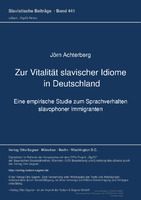Zur Vitalitaet slavischer Idiome in Deutschland
| dc.contributor.author | Achterberg, Jörn | |
| dc.date.accessioned | 2019-01-10 23:55 | |
| dc.date.accessioned | 2020-01-09 16:47:53 | |
| dc.date.accessioned | 2020-04-01T11:00:16Z | |
| dc.date.available | 2020-04-01T11:00:16Z | |
| dc.date.issued | 2005 | |
| dc.identifier | 1003970 | |
| dc.identifier | OCN: 1083021558 | en_US |
| dc.identifier.uri | http://library.oapen.org/handle/20.500.12657/26117 | |
| dc.description.abstract | Germany has gradually become Europe's largest immigration country and is increasingly shaped by the image of a multicultural and multilingual society. However, the issue of multilingualism receives little attention, especially with regard to Slavic migration idioms. The aim of the present study is the empirical investigation of the current language behavior of Slavophone immigrants and the determination of the vitality of their native languages. On the basis of a nationwide survey of 500 immigrants detailed microsociological data on the use of Slavic languages depending on persons, topics and situations will be collected and the influence of linguistic ecological factors such as attitudes, motivations, identity and social network of speakers on language use and language content will be investigated. In addition, on the basis of interdisciplinary approaches to the description of linguistic minorities, the vitality of slavins is analyzed comparatively, showing the current situation and the future development of Slavia in Germany in general and specific tendencies of ethnolects in particular. | |
| dc.language | German | |
| dc.relation.ispartofseries | Slavistische Beitraege | |
| dc.subject.classification | thema EDItEUR::C Language and Linguistics::CF Linguistics | en_US |
| dc.subject.other | Germany | |
| dc.subject.other | migration idioms | |
| dc.subject.other | immigration | |
| dc.subject.other | Achterberg | |
| dc.subject.other | Deutschland | |
| dc.subject.other | Ethnolinguistischen Vitalität | |
| dc.subject.other | Idiome | |
| dc.subject.other | Immigrantensprachen | |
| dc.subject.other | Immigration nach Deutschland | |
| dc.subject.other | Mehrsprachigkeit | |
| dc.subject.other | slavischer | |
| dc.subject.other | Sprachkontakt | |
| dc.subject.other | Vitalität | |
| dc.title | Zur Vitalitaet slavischer Idiome in Deutschland | |
| dc.type | book | |
| oapen.abstract.otherlanguage | Deutschland hat sich sukzessive zum größten Einwanderungsland Europas entwickelt und wird immer stärker vom Bild einer multikulturellen und multilingualen Gesellschaft geprägt. Dem Thema Mehrsprachigkeit aber wird insbesondere in Bezug auf slavische Migrationsidiome nur wenig Beachtung geschenkt. Ziel der vorliegenden Studie ist die empirische Erforschung des aktuellen Sprachverhaltens slavophoner Immigranten und die Bestimmung der Vitalität ihrer Muttersprachen. Anhand einer deutschlandweiten Enquete unter 500 Zuwanderern werden detaillierte mikrosoziologische Daten zum Gebrauch der slavischen Sprachen in Abhängigkeit von Personen, Themen und Situationen erhoben und der Einfluss sprachökologischer Faktoren wie Attitüden, Motivationen, Identität und soziales Netzwerk der Sprecher auf die Sprachverwendung und den Spracherhalt untersucht. Zudem wird auf der Grundlage interdisziplinärer Ansätze zur Beschreibung von Sprachminderheiten die Vitalität der Slavinen komparativ analysiert, womit die gegenwärtige Situation und die zukünftige Entwicklung der Slavia in Deutschland im Allgemeinen und spezifische Tendenzen der Ethnolekte im Besonderen aufgezeigt werden. | |
| oapen.identifier.doi | 10.3726/b12748 | |
| oapen.relation.isPublishedBy | e927e604-2954-4bf6-826b-d5ecb47c6555 | |
| oapen.relation.isbn | 9783954796267 | |
| oapen.series.number | 441 | |
| oapen.pages | 316 | |
| oapen.place.publication | Bern | |
| oapen.identifier.ocn | 1083021558 |

